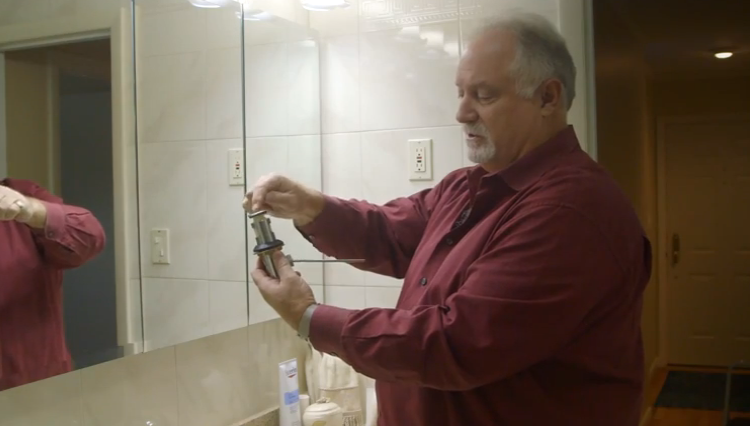Sponsored Content Brought To You By Alure Home Improvements
Most of us take our sink pop-up stopper for granted—until it stops working properly. Then we get that “sinking” feeling, and nobody wants that, especially in our house’s bathroom.
Fortunately, help is on the way, thanks to Alure Home Improvements’ Chief Operating Officer Doug Cornwell and this latest installment of the “60 Second Fix: How To Adjust The Pop Up In Your Sink In 60 Seconds.”
As Cornwell points out, the pop-up stopper basically serves two functions.
“One is to keep water in the sink, the other is to let the water out,” he says.
Generally, there are two common problems with this device, Cornwell says: “One is that the pop-up doesn’t stay up so it continually falls down. The other is that it doesn’t pop up high enough.”
The pop-up stopper is the knobbed rod on the sink that goes through the water faucet. When you lift it upwards, the mechanism that it’s attached to the under the sink pulls the stopper down onto the drain, forming a tight seal. And when you push the rod back down, it opens the drain stopper, letting the water out.
Of course, in order to do these fixes simply, you have to take some elementary steps first. Move everything from under the sink so you have enough room to maneuver.
Make sure that the horizontal pivot rod, which is attached to the sink’s drain pipe, is connected to the clevis, a flat piece of metal that connects to the vertical stopper rod and has four holes lined up vertically for one end of the horizontal pivot rod to go through.
On the other end of the pivot rod is a retaining nut that holds it in place to the drain pipe. If this retaining nut is too tight, the horizontal pivot rod won’t move. But if it’s too loose, then the pivot rod won’t function the way it’s intended.
As Cornwell explains, “When the water hits the stopper, it closes automatically.”
Tightening the retaining nut takes a light touch, Doug advises.
“You can do this with your hands,” he says. “You don’t really want to use a wrench!”
Once the nut is snug, the pop-up stopper rod should stay up when you pull it up, and not slide back down when the faucet is running.
Learn more about Alure Home Improvements HERE
The other common problem with the pop-up stopper takes a few more steps to correct.
If the pop-up stopper doesn’t go all the way up or down when you pull on it, then the stopper won’t be open all the way or seal tightly. This situation affects how fast the water will drain from the sink.
To fix it, you have to change the clevis hole that the horizontal pivot rod protrudes through. There’s a screw at the top of the clevis that lets the stopper rod slide up and down. This procedure might require a screwdriver. There may also be a clip holding the horizontal rod in place.
What you need to do to remedy this problem, as Doug shows, is make sure that there’s enough room for the pop-up stopper rod to rise to the proper height above the faucet and lock in the upright position without requiring too much pressure to release.
Take a look under the sink at the clevis and pick a lower hole for the horizontal pivot rod to go through so that the pop-up stopper rod is in its lowest position. The clevis screw can help you make the final adjustment once the horizontal pivot rod is in its new hole.
“Set the lift rod so it’s all the way down!” Doug says.
So, with a little ingenuity, and a bit of patience, another simple problem is solved right before your eyes thanks to Doug Cornwell and Alure Home Improvements!
































